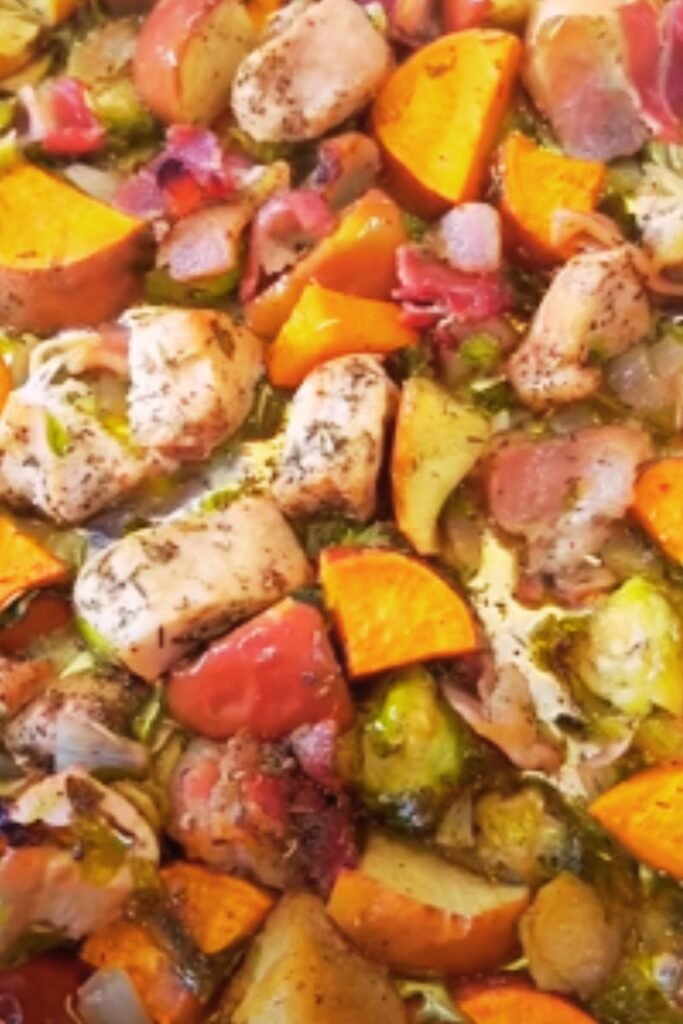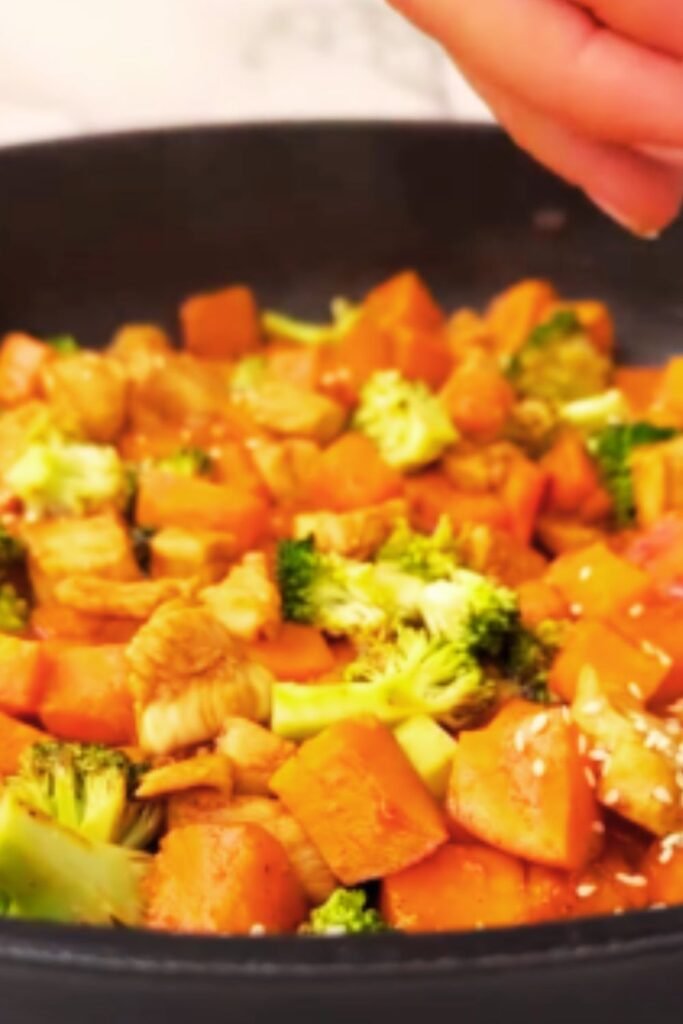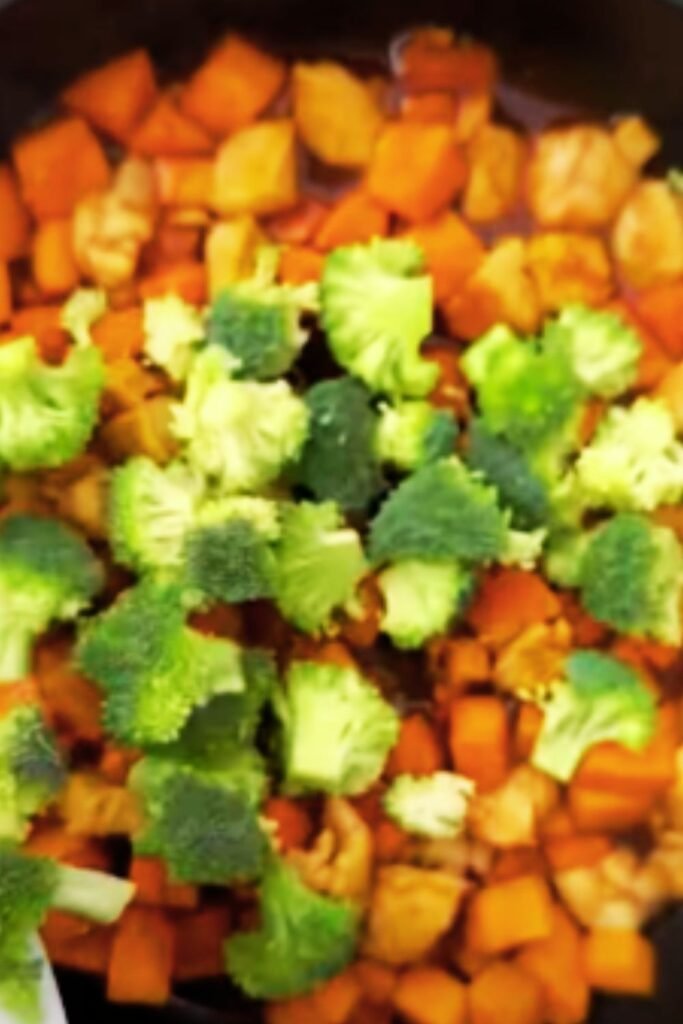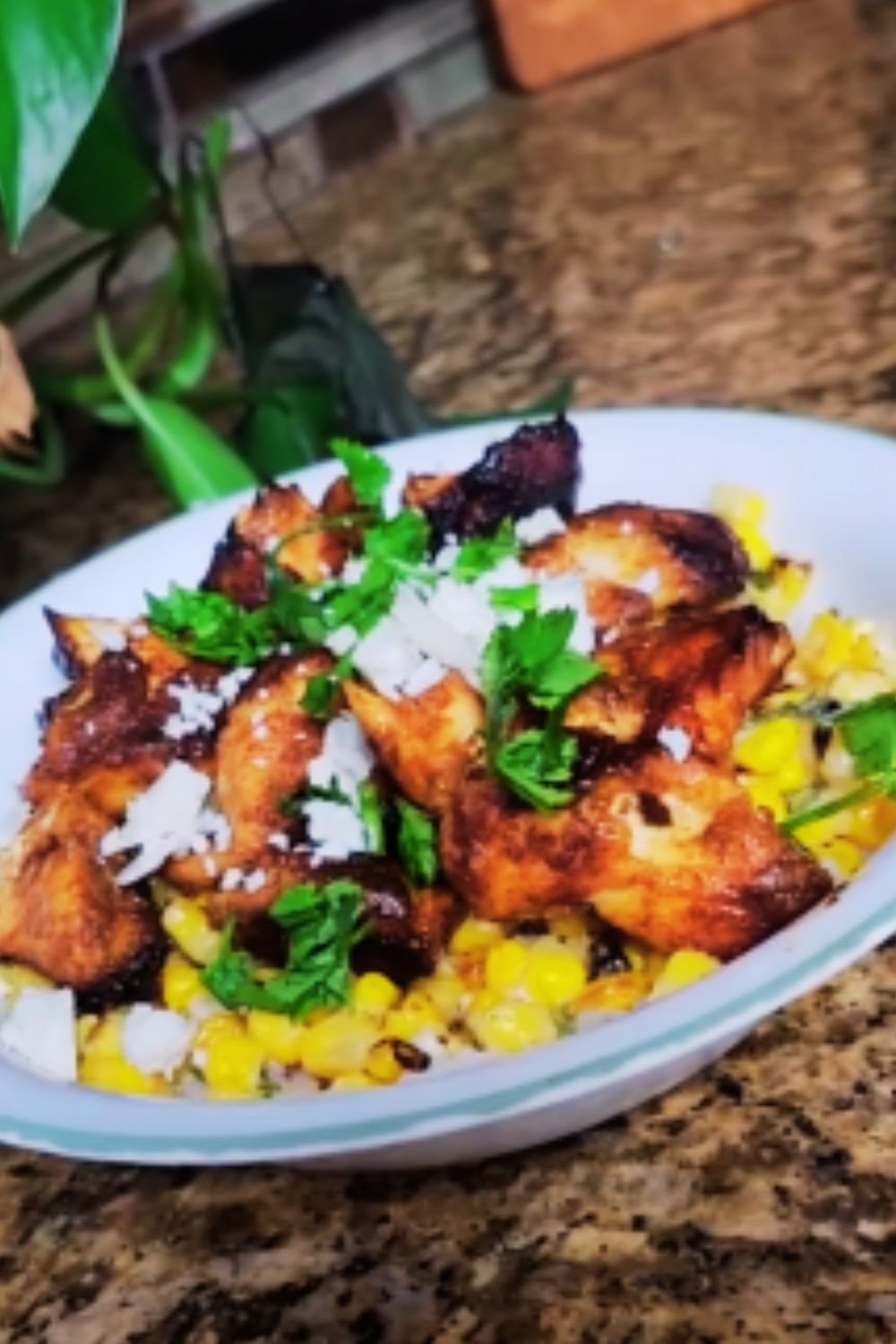There’s something magical about a meal that comes together in a single pan. As someone who values both flavor and efficiency in the kitchen, I’ve spent years perfecting recipes that deliver maximum taste with minimal cleanup. This One-Pan Chicken and Sweet Potato Skillet has become a staple in my weekly rotation, and for good reason. It combines tender chicken thighs, caramelized sweet potatoes, and a medley of vegetables in a harmonious blend that feels both nourishing and indulgent.
What makes this dish particularly special is the way the chicken renders its flavorful fat, which then becomes the cooking medium for the sweet potatoes and other vegetables. The result is a symphony of flavors where each ingredient contributes something essential to the final composition. The sweet potatoes develop a perfect caramelization that balances their natural sweetness, while the chicken skin crisps up beautifully against the hot cast iron.
I first developed this recipe during a particularly busy season when I needed wholesome dinners that wouldn’t keep me tethered to the kitchen. Now it’s my go-to recommendation whenever friends ask for a foolproof dinner idea that feels special enough for company but simple enough for a Wednesday night.
Ingredients You’ll Need
Before diving into the cooking process, let’s gather everything we need for this satisfying skillet dinner:
For the Chicken Marinade:
- 6 bone-in, skin-on chicken thighs (about 2 pounds)
- 2 tablespoons olive oil
- 3 cloves garlic, minced
- 1 tablespoon fresh thyme leaves (or 1 teaspoon dried)
- 1 tablespoon fresh rosemary, chopped (or 1 teaspoon dried)
- 1 teaspoon smoked paprika
- 1 teaspoon salt
- ½ teaspoon freshly ground black pepper
- Zest of 1 lemon
For the Skillet:
- 2 medium sweet potatoes (about 1 pound), cut into 1-inch cubes
- 1 large red onion, cut into wedges
- 2 bell peppers (preferably different colors), sliced into strips
- 1 cup cherry tomatoes, halved
- 3 cloves garlic, thinly sliced
- 2 tablespoons olive oil
- 1 tablespoon balsamic vinegar
- 1 teaspoon dried oregano
- ½ teaspoon red pepper flakes (adjust to taste)
- Salt and freshly ground black pepper, to taste
For Garnish:
- ¼ cup fresh parsley, chopped
- 2 tablespoons fresh basil, torn
- Lemon wedges for serving
Equipment Needed
One of the beauties of this recipe is its simplicity in terms of equipment. Here’s what you’ll need:
- 12-inch cast iron skillet (preferred) or other oven-safe skillet
- Mixing bowls
- Cutting board and sharp knife
- Measuring spoons and cups
- Tongs for flipping chicken
- Instant-read thermometer (optional but helpful)
Preparation: The Key to Skillet Success
I’ve found that the difference between a good skillet dinner and a great one often comes down to preparation. Taking the time to properly prepare your ingredients ensures that everything cooks evenly and comes together harmoniously.
Step 1: Marinate the Chicken
For the most flavorful results, I recommend marinating the chicken for at least 30 minutes, though you can extend this to overnight if you’re planning ahead.
- In a large bowl, combine olive oil, minced garlic, thyme, rosemary, smoked paprika, salt, pepper, and lemon zest.
- Add chicken thighs to the bowl and massage the marinade into the meat, making sure to get some under the skin where possible.
- Cover and refrigerate for at least 30 minutes or up to 24 hours.
Step 2: Prep Your Vegetables
Uniform sizing is crucial when cutting your vegetables, particularly the sweet potatoes. This ensures everything cooks evenly.
- Wash and peel sweet potatoes, then cut into 1-inch cubes.
- Cut the red onion into wedges, keeping the root end intact to hold each wedge together.
- Remove seeds from bell peppers and slice into strips about ½-inch wide.
- Halve the cherry tomatoes and thinly slice the garlic.

Step 3: Let the Chicken Come to Room Temperature
About 30 minutes before cooking, remove the marinated chicken from the refrigerator and allow it to come to room temperature. This promotes even cooking and helps the skin crisp up better.
The Cooking Process: Building Layers of Flavor
Now that everything is prepped, it’s time to bring this dish to life. The key is to develop flavor at each stage of the cooking process.
Step 1: Preheat Your Equipment
- Position a rack in the middle of your oven and preheat to 425°F (220°C).
- Place your cast iron skillet over medium-high heat and allow it to become properly hot, about 3-4 minutes.
Step 2: Sear the Chicken
- Add 1 tablespoon of olive oil to the hot skillet.
- Place chicken thighs skin-side down in the skillet, being careful not to overcrowd the pan. Work in batches if necessary.
- Sear until the skin is golden brown and crispy, about 5-7 minutes. Resist the temptation to move the chicken around—let it develop that beautiful crust.
- Flip the chicken and sear the other side for 3 minutes.
- Transfer chicken to a plate and set aside. It will not be fully cooked at this point, which is exactly what we want.
Step 3: Build the Vegetable Base
- In the same skillet, using the rendered chicken fat and adding the remaining tablespoon of olive oil if needed, add sweet potato cubes.
- Cook for about 5 minutes, stirring occasionally, until they begin to brown.
- Add onion wedges and continue cooking for 3 minutes.
- Stir in bell pepper strips, sliced garlic, and red pepper flakes. Cook for 2 minutes more.
- Add cherry tomatoes, balsamic vinegar, and dried oregano. Season with salt and pepper.
- Stir everything together, scraping up any browned bits from the bottom of the skillet (these contain tons of flavor!).
Step 4: Combine and Finish in the Oven
- Create small wells among the vegetables and nestle the seared chicken thighs back into the skillet, skin-side up.
- Pour any accumulated juices from the plate back into the skillet.
- Transfer the skillet to the preheated oven and roast for 20-25 minutes, or until the chicken reaches an internal temperature of 165°F (74°C) and the sweet potatoes are tender when pierced with a fork.

Step 5: Rest and Garnish
- Once done, remove the skillet from the oven and let it rest for 5 minutes. This allows the juices to redistribute within the chicken.
- Sprinkle fresh parsley and torn basil over the top.
- Serve directly from the skillet with lemon wedges on the side for squeezing over the dish.
Nutritional Information
Understanding the nutritional profile of what we eat helps us make informed choices. Here’s a breakdown of what you’re getting in each serving of this One-Pan Chicken and Sweet Potato Skillet:
| Nutrient | Amount per Serving | % Daily Value* |
|---|---|---|
| Calories | 485 | – |
| Total Fat | 24g | 31% |
| Saturated Fat | 5g | 25% |
| Cholesterol | 142mg | 47% |
| Sodium | 670mg | 29% |
| Total Carbohydrate | 28g | 10% |
| Dietary Fiber | 5g | 18% |
| Sugars | 8g | – |
| Protein | 38g | 76% |
| Vitamin A | 18,500 IU | 370% |
| Vitamin C | 85mg | 142% |
| Calcium | 75mg | 8% |
| Iron | 3.2mg | 18% |
*Percent Daily Values are based on a 2,000 calorie diet. Your daily values may be higher or lower depending on your calorie needs.
This dish is particularly rich in vitamin A from the sweet potatoes and bell peppers, which supports eye health and immune function. The protein content from the chicken thighs helps with muscle maintenance and satiety.
Variations to Keep Things Interesting
One of the reasons I love this recipe is its versatility. Here are some variations I’ve tried and loved:
Mediterranean Version:
- Add kalamata olives, artichoke hearts, and crumbled feta cheese before serving
- Substitute oregano and thyme for the herb mixture
- Finish with a drizzle of good quality olive oil
Autumn Harvest:
- Add 1 cup of cubed butternut squash along with the sweet potatoes
- Include 2 cored and sliced apples during the last 10 minutes of cooking
- Incorporate 1 teaspoon of cinnamon and ½ teaspoon of nutmeg to the seasoning
- Garnish with toasted pecans instead of herbs
Spicy Southwest:
- Use chipotle powder instead of smoked paprika
- Add 1 can of drained black beans when returning the chicken to the skillet
- Include 1 cup of corn kernels
- Garnish with cilantro, lime wedges, and avocado slices
Root Vegetable Medley:
- Incorporate parsnips, carrots, and turnips along with the sweet potatoes
- Add 2 tablespoons of maple syrup to the vegetable mixture
- Use sage and rosemary as your primary herbs
Storage and Reheating Instructions
This dish makes excellent leftovers, which is another reason why it’s such a practical addition to your recipe collection.
Storage:
- Allow the dish to cool completely before storing.
- Transfer leftovers to an airtight container.
- Refrigerate for up to 3 days.
Reheating:
- Oven Method (Preferred): Preheat oven to 350°F (175°C). Place leftovers in an oven-safe dish, add 2 tablespoons of chicken broth or water, cover with foil, and heat for 15-20 minutes until warmed through.
- Stovetop Method: Add a small amount of oil to a skillet over medium heat. Add leftovers and 2 tablespoons of water or broth, cover, and heat until warmed through, stirring occasionally.
- Microwave Method: While not ideal for preserving the texture, you can microwave individual portions in a covered container with a splash of water for 2-3 minutes, stirring halfway through.
Serving Suggestions
To turn this already satisfying dish into a complete meal experience, consider these serving suggestions:
Side Options:
- A simple green salad with a light vinaigrette
- Steamed green beans or asparagus
- Crusty whole grain bread to soak up the delicious juices
- Quinoa or brown rice for additional whole grains
For a Special Touch:
- Serve with a dollop of Greek yogurt mixed with lemon zest and a touch of honey
- Offer a side of homemade cranberry sauce for a sweet-tart contrast
- Prepare a simple cucumber and tomato salad with fresh mint

Pro Tips for Skillet Success
After making this dish countless times, I’ve picked up several tips that make a significant difference in the final result:
- Use a well-seasoned cast iron skillet if possible. It retains heat beautifully and creates the best sear on the chicken.
- Don’t skimp on the searing time for the chicken. Those extra minutes developing a golden crust translate directly to flavor in the finished dish.
- Cut vegetables to similar sizes for even cooking, especially the sweet potatoes.
- If your chicken skin isn’t as crispy as you’d like after the oven time, you can place the skillet under the broiler for 1-2 minutes at the end. Watch carefully to prevent burning!
- Season at every stage of cooking rather than just at the beginning or end. This builds layers of flavor throughout the dish.
- Allow ingredients to come to room temperature before cooking when possible. Cold chicken straight from the refrigerator won’t sear as effectively.
- Don’t overcrowd the pan when searing the chicken. Work in batches if necessary to ensure proper browning.
- Use a meat thermometer to check chicken doneness. This prevents overcooking and dry chicken.
Common Questions and Solutions
Over the years, I’ve received numerous questions about this recipe. Here are the most common ones along with their solutions:
Q: Can I use boneless, skinless chicken thighs instead? Yes, you can, though you’ll lose some flavor from the skin and bones. If using boneless skinless thighs, reduce the oven time to about 15-18 minutes and check for doneness.
Q: What if I don’t have a cast iron skillet? Any oven-safe skillet will work. If you don’t have an oven-safe skillet, you can sear the chicken and cook the vegetables in a regular pan, then transfer everything to a baking dish for the oven portion.
Q: Can I substitute chicken breasts for thighs? Yes, though chicken breasts tend to dry out more easily. If using breasts, consider brining them first (soak in a solution of 1/4 cup salt dissolved in 4 cups water for 30 minutes, then rinse and pat dry). Also, reduce the oven time to prevent overcooking.
Q: How can I make this dish spicier? Increase the red pepper flakes to 1 teaspoon, or add a diced jalapeño or serrano pepper when cooking the bell peppers. You could also add a dash of cayenne pepper to the chicken marinade.
Q: Can I meal prep this recipe? Absolutely! You can prepare all ingredients (marinate the chicken, chop vegetables) up to a day in advance and store separately. You can also fully cook the dish and portion it into containers for quick reheating throughout the week.
Q: My sweet potatoes aren’t cooking through. What am I doing wrong? This usually happens if the sweet potato pieces are cut too large or unevenly. Aim for 1-inch cubes and make sure they’re consistent in size. If you find they’re still not done when the chicken is, remove the chicken from the skillet, cover it with foil to keep warm, and continue cooking the vegetables until tender.
Q: Is there a way to make this vegetarian? Yes! Replace the chicken with extra-firm tofu (pressed and marinated the same way as the chicken) or portobello mushroom caps. Cook time for either would be reduced to about 15 minutes in the oven.
Q: How can I reduce the calories in this dish? Use skinless chicken thighs and reduce the oil by half. You might also substitute part of the sweet potatoes with lower-calorie vegetables like zucchini or bell peppers.
Why This Recipe Works: The Science Behind the Skillet
Understanding the science behind cooking helps us become better cooks. Here’s what makes this recipe particularly successful:
The Maillard Reaction
When we sear the chicken skin at high heat, we’re initiating the Maillard reaction—a chemical reaction between amino acids and reducing sugars that gives browned food its distinctive flavor. This reaction creates hundreds of different flavor compounds, adding complexity to our dish.
Flavor Transfer
By cooking the vegetables in the same pan as the chicken, we’re utilizing the rendered fat and browned bits (called fond) left in the skillet. These contain concentrated flavors that get absorbed by the sweet potatoes and other vegetables.
Steam Retention
The oven portion of cooking creates a mini enclosed environment where steam helps cook the vegetables while the dry heat continues to crisp the chicken skin. This dual cooking environment yields tender vegetables and crispy chicken.
Complementary Ingredients
Sweet potatoes contain natural sugars that caramelize during cooking, offering a counterpoint to the savory chicken. The acidity from the balsamic vinegar and tomatoes helps cut through the richness of the dish, while herbs add aromatic complexity.
Final Thoughts: Why This Dish Deserves a Place in Your Rotation
After years of refining one-pan recipes, this Chicken and Sweet Potato Skillet stands out as one of my favorites. It strikes that elusive balance between being healthy and satisfying, simple yet impressive. It’s adaptable to what you have on hand and scales easily for different household sizes.
What I appreciate most about this dish is how it transforms ordinary ingredients into something extraordinary through thoughtful cooking techniques. The contrast between the crispy chicken skin and the tender, flavorful meat, paired with caramelized sweet potatoes and vegetables bathed in the pan juices, creates a meal that feels like comfort food elevated.
Whether you’re cooking for yourself, your family, or guests, this skillet dinner communicates care and attention without demanding hours in the kitchen. And perhaps best of all, when dinner is done, there’s just one pan to clean.
I hope this recipe becomes as beloved in your home as it is in mine. Happy cooking!


